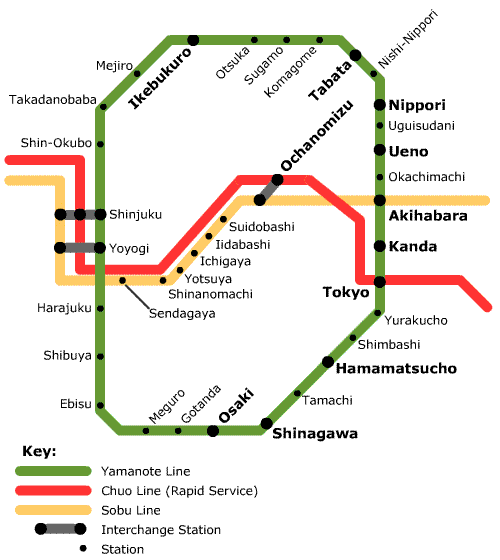(This is the last post of my HAJIMEMASHITE, NIHON series; and i thought it would be nice to write down assorted thoughts/musings/insights which would hopefully be helpful for first-timers to Tokyo. Personally, i'm raring to go back! ;-D)
1. Getting Around
Whilst planning the trip, this was actually my greatest apprehension - the fear of getting lost amidst the hustle and bustle of Tokyo, and having difficulty in getting directions due to the language barrier.
The Tokyo public transport system is certainly one of the most extensive in the world; and is even more certainly confusing at first glance. For example, check out this official subway map from WhereinTokyo site:
Looks pretty daunting, eh? In fact, i'm willing to bet only locals and the cartographer who did it can actually understand it! :D
But fret nor fear not, dear tourist. The Grumpy Urban Slacker is here! #kapalmuks
The key is to forget (yes, forget) about this map, and instead remember this one - the Japan Railways (JR) Yamanote line (i.e. the "green" line), an above-ground train system which loops around the major tourist sites in Tokyo.
Infinitely simpler, huh? A good starting point would be to stay in a hotel near a major Yamanote line station (such as Shibuya, Shinagawa, Ikebukuro and Tokyo), and figure out which station(s) is/are nearest the particular tourist site(s) you want to visit. In most cases, you will just ride along the green loop (a major exception being a trip to Tsukiji Market, which would involve changing to a subway line).
Here's a link to a summary of tourist sites near each Yamanote station: http://www.japan-guide.com/e/e2370.html
2. English, English
We found English comprehension to be surprisingly good in the major train stations, convenience stores, retail shopping areas and restaurants, etc., but it can be patchy in suburban Tokyo.
Learning a few key sentences of Nihongo would definitely help endear you to the locals. I particularly recommend the 'Teach Yourself' audio series of Elizabeth Smith.
3. Local customs
One thing i noticed was that the locals do not carry around food & drink (such as soda, Starbucks coffee, donuts, etc.) while walking around, so i would not recommend doing so. Besides, it can be difficult to find a public trash can to throw your leftovers and/or packaging to.
Believe me, even the busiest subway stations such as Shibuya hardly have garbage bins, not even inside their restrooms.
Likewise, observe decorum while riding the subway and/or trains. There is almost total silence in transit, as locals either look half-asleep with glazed expressions (especially office workers in suits and ties); or busy playing games on their phones/tablets; or reading books. No boisterous chatter here.
4. Food
When in Japan, eat Japanese food, period. We had this eat-all-you-can Yakiniku (grilled meat) in Shinjuku during our last night. Expensive, but you get your money's worth. Drank this sake (rice wine), which was pretty smooth.
Some other good meals: Small no-English tempura (fried shrimp) joint below the train tracks of Yurakucho station, check.
Fastfood-y rice bowl and gyoza (dumpling) outlets, check. A no-English ramen (noodle) place off Omotesando Hills in Harajuku, check!
I remember this bowl of ramen, plus one order of pork gyoza, came to less than 800 Yen. Perfect lunch for a cold, overcast, slightly rainy day.
This sushi (raw fish on rice) restaurant named KIZUNA we stumbled on in Kabuki-cho, Tokyo's red light district. Check!!
Dig this sashimi platter, bursting with freshness! My HDL cholesterol levels are zooming already!
Tsukiji Market sushi breakfast, a giant check!
My conclusion: A bad meal is hard to find in Tokyo. In fact, forget about researching the Michelin star restaurants, or the lists of "best" sushi/ramen/katsu/etc. joints, or celebrity chef places.
Plus, prices aren't as high as one would be led to believe (somehow, people have this preconception that Tokyo is hugely expensive). It is not cheap, definitely; but you can definitely find something good for 1000 Yen or below.
Most department stores have basements which serve as some sort of food court, with different stalls offering freshly cooked viands for takeout. In particular, the Seibu branch in Ikebukuro was full of tempting food and desserts! Definitely great value for money.
5. Accommodations
Hotels, hostels and inns of all shapes and for all budgets can be found; but location is key. We stayed at the Shibuya area, which i heartily recommend. I was glad we didn't stay in Shinjuku, as i found the area to be confusing and too loud for my taste.
If you want to try something uniquely Japanese (and cheap), stay in a capsule hotel. Check out fellow blogger Hello Newman's vivid account of his overnight stay in one:
http://www.hello1newman.blogspot.com/2010/06/capsules-arent-just-for-swallowing.html
So book your ticket, plan your itinerary, and go! All together now, Ohayo Gozaimasu Tokyo!







No comments:
Post a Comment